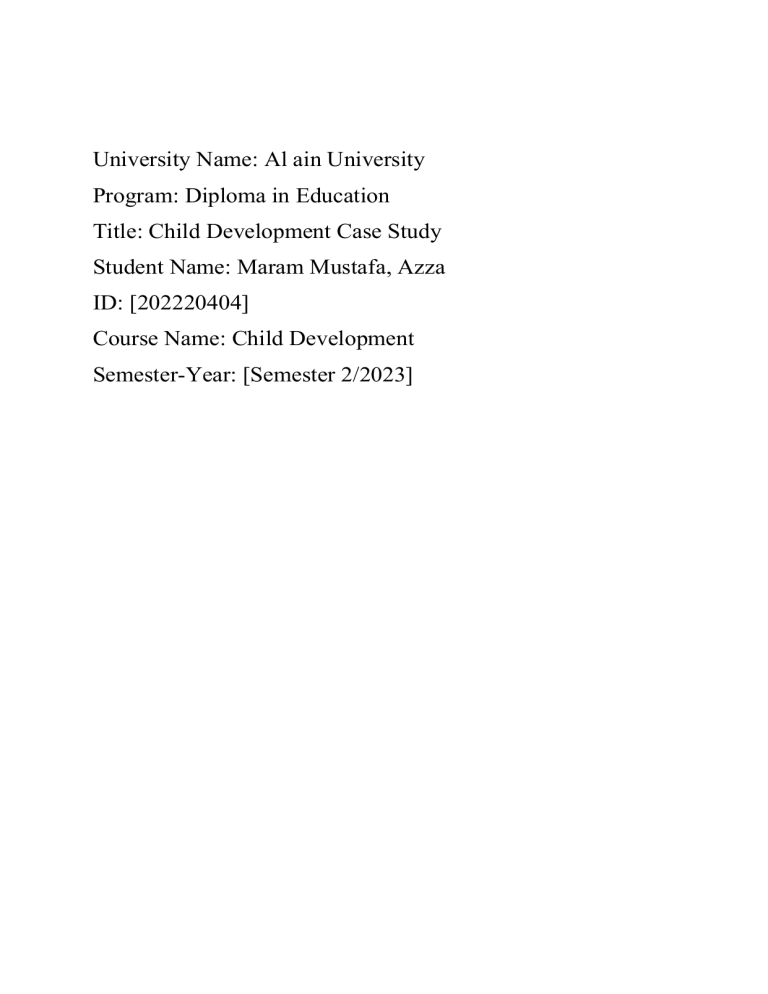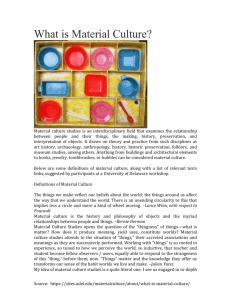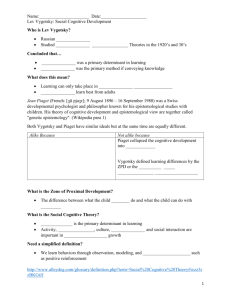
University Name: Al ain University Program: Diploma in Education Title: Child Development Case Study Student Name: Maram Mustafa, Azza ID: [202220404] Course Name: Child Development Semester-Year: [Semester 2/2023] Arwen, a 7-year-old girl who has shown her skills in a variety of tasks linked to her cognitive, social, physical, and moral development, is the subject of this report's case study. The study analyses her performance on three tasks considering Piaget's theory of cognitive development, Vygotsky's sociocultural theory, and Baddeley's working memory model, which are three theories of child development. Arwen's family, mental, physical, and socioeconomic circumstances are also covered in the report, along with suggestions for intervention tactics. The process of child development is intricate and varied, including the interaction of many biological, psychological, and social elements. In this essay, we'll use a case study of Arwen, a 7-year-old girl, to apply three theories of child development. Piaget's theory of cognitive development, Vygotsky's sociocultural theory, and Baddeley's working memory model are the theories that were chosen. As we analyse Arwen's performance in working memory, scaffolding, and conservation of volume tasks, we will compare it to the predictions made by these theories. Aspects of Development: Piaget's theory of cognitive development, Erikson's theory of psychosocial development, and Vygotsky's sociocultural theory are the three theories I've chosen to comprehend Arwen's development. Many facets of growth, such as cognitive, emotional, and social development, are highlighted by each theory. 1. The Piaget Theory of Cognitive Development is divided into two parts. According to Piaget's theory, kids between the ages of 7 and 11 who are in the concrete operational stage are capable of reasoning rationally and comprehending mass, volume, and number conservation. The conservation of volume task, which involves pouring water from a tall, narrow glass into a short, wide glass and asking the kid which glass has more water, is one activity that Arwen may be expected to accomplish in light of this idea. 2. Vygotsky's Sociocultural Theory: Under Vygotsky's theory, social interaction and cultural background are significant factors in learning and growth. According to this hypothesis, Arwen might be required to finish a work that entails scaffolding or learning with the assistance of a more experienced person. For instance, a teacher or parent who is fluent in Arabic could be asked to help Arwen learn a new term in the language. 3. Information Processing Theory: In accordance with this hypothesis, changes in a child's brain's ability to process information cause their cognitive capacities to get better as they get older. According to this idea, one job that Arwen would be required to perform is a working memory task, such as recalling a brief list of words or numbers and then repeating them again. II. A Case Description Arwen, a 7-year-old girl, lives in a suburban neighbourhood with her parents, two siblings, and other family members. Her family prioritizes education and has a middling socioeconomic standing. Arwen studies at a private school where she excels in English classes but finds it challenging to understand Arabic. She enjoys sports and outdoor activities, is physically fit, and has good hand-eye coordination. Arwen is sociable, has a few close friends, and enjoys playing group games. Child Development III The way Arwen performs on the chosen tasks reveals information about her moral, social, intellectual, and physical growth. 1. Cognitive Development: Arwen's performance in the task requiring the conservation of volume is consistent with Piaget's theory of cognitive development, which contends that children's capacities for logical thought and comprehension of the conservation of mass, volume, and number develop over time. Arwen has entered the concrete operational stage of cognitive development since she was able to recognize that the volume of water remained the same despite the change in container shape. 2. Social Development: Arwen's accomplishments in the scaffolding exercise are consistent with Vygotsky's sociocultural theory, which emphasizes the need of social guidance and interaction in young children's cognitive development. Arwen originally had difficulty pronouncing the Arabic word, but with repetition and feedback, she was able to do so. This implies that Arwen might use more assistance and practice studying Arabic, which could be given through interpersonal connection with a teacher or tutor. 3. Physical Development: Arwen's success in the working memory test is consistent with the working memory model proposed by Baddeley, which contends that working memory is a transient store that enables people to hold and alter information in their minds. Arwen's increasing working memory skills, a crucial component of her physical development, were evident in her ability to recall and correctly repeat back the list of five words. IV. Case Analysis Considering the three theories of child development, the case of Arwen can be examined. Her performance in the trials matched the theories' predictions, indicating that she is maturing cognitively, socially, and physically in accordance with milestones for her age. Her struggles with Arabic, nevertheless, might necessitate more focused therapy. Arwen was able to complete the conservation of volume task satisfactorily at the age of 7, which is consistent with Piaget's theory of cognitive development. This demonstrates Arwen's capacity for logical thought and her understanding of the conservation of mass, volume, and number. According to Kohlberg's theory of moral development, kids Arwen's age are in the heteronomous morality stage, which implies they think rules shouldn't be broken in order to avoid punishment. Although the activities did not explicitly examine Arwen's moral growth, her effective completion of the tasks shows that she was adhering to the rules and instructions, which is consistent with Kohlberg's thesis. The importance of social connections and scaffolding in a child's development is emphasized by Vygotsky's sociocultural theory. Arwen may require additional assistance and practice to learn Arabic, as seen by her challenges with the scaffolding task. This emphasizes the significance of customized interventions that give proper scaffolding and support and take into account the sociocultural environment of a child's learning. The physical growth of Arwen V. Recommended Intervention Strategies: The following intervention techniques are recommended to support Arwen's learning and development: 1. Give Arwen more specialized support and practice to help her learn Arabic. Arwen is having trouble learning Arabic, so it's crucial to give her extra practice and support to help her. This may entail private instruction, additional Arabic classes, and drill sessions. 2. Promote social interaction: Arwen is making progress in her social development, so it's critical to motivate her to keep talking to adults and her peers. Her linguistic development, self-assurance, and emotional health can all be supported by social connection. 3. Provide her tasks that will test her cognitive talents. Arwen has shown that she has great cognitive abilities, therefore it's crucial to offer her tasks that will test those abilities. Conclusion Arwen appears to be maturing in line with expected milestones based on the way her performance on the tests matched those predicted by theories of cognitive and social development. Her struggles with Arabic, nevertheless, might necessitate more focused therapy. We can promote Arwen's learning and growth by giving her extra assistance and practice with her Arabic, promoting social engagement, and providing her with tasks that stretch her cognitive capacities. Resources: Berk, L. E. (2013). a child's growth. Pearson. J. Piaget (1952). the beginnings of children's intelligence. Worldwide Universities Press L. S. Vygotsky (1978). The advancement of higher psychological processes in society.



